Quadrature Amplitude Modulation IP
Welcome to the ultimate Quadrature Amplitude Modulation IP hub! Explore our vast directory of Quadrature Amplitude Modulation IP
All offers in
Quadrature Amplitude Modulation IP
Filter
Compare
18
Quadrature Amplitude Modulation IP
from
9
vendors
(1
-
10)
-
Multi-channel Cable Modulator
- The CMS0024 Multi-channel Cable Modulator encodes up to four separate transport streams for J83 or DVB-C.
- The resulting QAM symbols are filtered and up-converted, each channel to its own frequency division multiplex (FDM) sub channel.
- The IF channels are then combined output to the radio interface as a single I/Q sample stream for translation to the final RF frequency.
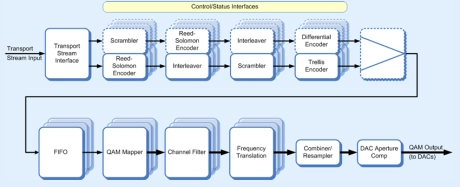
-
Multi-mode QAM Demodulator
- IF sub-sampling or I/Q baseband interface.
- Variable ADC width support.
- Single external clock source required.
- Single external analogue loop for AGC.
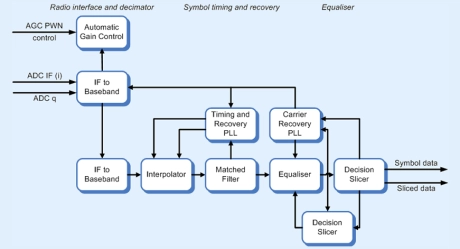
-
Universal QAM/PSK Modulator
- The CMS0004 Universal QAM/PSK Modulator is a flexible, high-performance, linear modulator core designed for a wide range of broadband applications including point-to-point and point-to-multipoint terrestrial, satellite and wireline transceiver systems.
- It supports both continuous and burst-mode operation and its synchronous control interface readily accommodates physical-layer protocols that employ variable-rate frame structures.

-
Quadrature Amplitude Modulation: Modulator and Demodulator
- 1. Quadrature amplitude modulation Aside from increased channel capacity, QAM has various other advantages, which are stated below.
- 2. One of the most significant advantages of QAM is its ability to sustain a high data rate. As a result, the carrier signal can carry a certain amount of bits. Because of these benefits, it is preferred in wireless communication networks.
- 3. The noise immunity of QAM is quite strong. Noise interference is a bit low as a result of this.
- 4. It has a low mistake probability value.
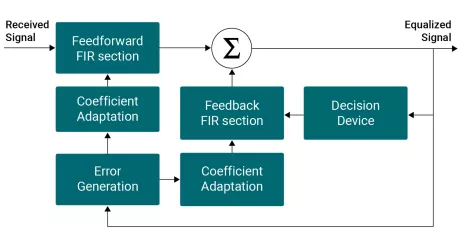
-
OFDM Baseband Processor
- Customized transmit and receive physical layer chains.
- Fully synchronous design enabling high throughput TDD operation.
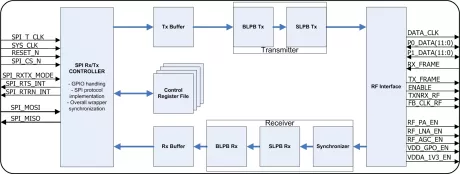
-
Configurable Soft Output Demapper
- Soft output demapper based on the LLR (Log Likelihood Ratio)algorithm.
- Parameterized number of soft bits per symbol .
- Parameterized architecture depending on supported modulation levels for optimum resources utilization.
- Programmable modulation level.
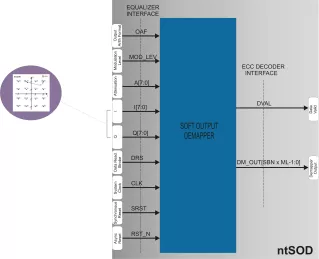
-
Mobile Phase Recovering Equalizer
- 17-tap complex-arithmetic LMS Channel Equalizer with adaptation bandwidth and leakage rate control as well as independent coefficient hold and reset controls
- VV4 Quasi-Coherent Demodulator for signal phase recovery and differential detection
- Integrated Symbol Slicer provides demodulated soft-decision outputs
- AGC output controls in proportional and up/dn format for constant-modulus and phase-locked processing
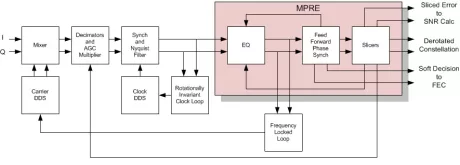
-
MMSE MIMO Detector
- Adaptable to different transmitter/receiver antenna configurations (e.g., 2×2, 4×2 or 4×4).
- Support for different modulation schemes at run-time (QPSK, 16-QAM, 64-QAM, 256-QAM)
- QR decomposition included
-
High Performance VSB/QAM Demodulator Core
- Input interface supports standard IF, low IF, and zero IF tuners.
- 12-bit data interface provides dynamic range needed for effective suppression of adjacent channel interference.
- Digital SAW filter reduces external part count.
- Robust, proprietary acquisition algorithm for better than 100 millisecond acquisition time over a wide range of inputs.
-
ISDB-T Demodulator
- Full 13-segment ISDB-T demodulator
- ARIB STD-B31 compliant supporting 1, 2 or 3-layers
- High-performance demodulation engine for demanding applications
- Sophisticated channel impairment correction